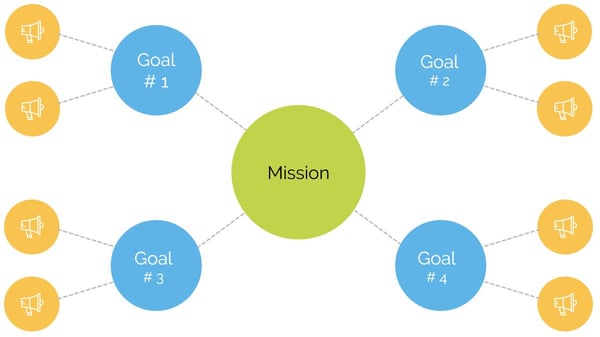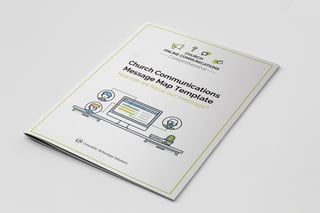
The last four sessions of our Online Church Communications Comprehensive focused primarily on high-level strategy. Now we'll start to transition to some lessons that are a bit more detailed and have practical implications on your day-to-day communications.
The first step in this direction is to focus your communication on a few key messages. A long-standing practice within public relations and communications is to develop a message map.
What is a message map?
A message map is a visual representation of your primary messages developed for the sake of aligning and prioritizing your communication. It shows how every individual message connects to the secondary messages (church goals), which connect to the primary message, the mission of your church.
The example below is a simple outline of the core parts of a message map, showing that the mission of the church (the Great Commission) is in the center, the church goals flow from that, and they point to the individual messages (the microphones).

Getting Started
The process of planning out your message map starts with writing the central message of your congregation. For many churches, this central message will be the Great Commission, but for others, it may be their Mission Statement or their Vision Statement.
From this point, list your church goals. As explained in a previous post, your church goals should flow from the Great Commission, not serve as a replacement. Your goals should be the way your church is pursuing it in this time and place.
The next step is to identify the ways that your church is pursuing your goals. These actions, whether they are ongoing ministries or specific events, are your messages and should not change frequently. You might have done this while determining your goals, but if not, now is a great time to do that.
As you do that, you might identify ministries or efforts that do not align with any of your goals. This might be a sign that those ministries need to be reevaluated, and it is best to leave them off the message map rather than trying to force them to align with a goal.
Next, provide 2-4 talking points for each of your messages. These may change frequently as activities and events are completed and new ones are planned.
Lastly, one helpful step that is not a requirement of a message map is to color-code the goals, messages, and talking points by persona. This will make it easier to find what is most relevant to your different audiences.
Why are message maps important?
Message maps help you keep the messages aligned, regardless of who is speaking. Once you have completed your message map and have trained your church staff and volunteers, you can be assured that they will always have something to say when speaking about your church, and what they say will always point back to the primary message.
Having a defined message map also helps you prioritize your communication. If you receive requests to include additional information in the newsletter or verbal announcements made before the service, you can use the message map as your guide for determining which should be included and which should not. Excluding something does not mean that it was a bad announcement, this just means it didn't lead towards accomplishing your church goals.
What are some practical ways to use message maps in the church?
- Bulletin/newsletter prioritization
Message maps not only help you prioritize what you should include in the church newsletter or bulletin, but they can also help you structure your messages. As you begin to see which goal each message supports, you can place it near other messages that support the same goal. - Social media posts
It's important to regularly post on social media, whether it's Facebook, Instagram, or Twitter, but it can be hard to come up with new posts several times a week. Referring back to your message map is a quick and easy way to come up with ideas for your posts on a daily basis, and because each message supports your goals, all of these posts will be beneficial. - In-church announcements
Announcements before or after the church service are important because you have the congregation's (mostly) undivided attention, but it's important not to waste that attention by making announcements that are not relevant to everyone in the church. Framing your announcements through the lens of your church goals will show the congregation why each message is important, even if it is not directly relevant to them. - Church website navigation
While it should not be a direct one-for-one relationship, your church website navigation should closely align with your message map. Every visitor of your website, whether a member or not, should be able to quickly identify the priorities of your church from a short visit to your website. In other words, every visitor to your church website will make assumptions about the priorities of your church based on what you prioritize on your website.
The process of developing a message map for your church communication has many more applications for your church. Even things outside of communications, from meeting agendas to budgets to time management, should align with your message map because it points back to your church goals which ultimately point back to the most important message: the Gospel.

Start Creating Your Message Map
Download the Church Communications Message Map Template. This is a free PDF that provides a sample message map as well as a template that can be used as a starting point to help you develop a message map for your church communications.

Free Training Course
This blog post was part of the training series Church Online Communications Comprehensive. All the course materials are available online for free, and you can move through the course at your own pace. Start working toward an effective online communications strategy for your church today!
About the Author
Follow on Linkedin More Content by Peter Frank























